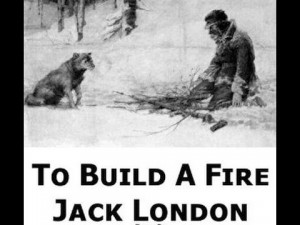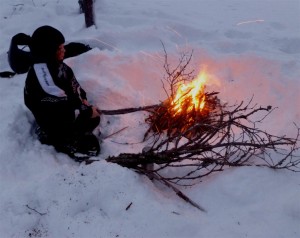In the public imagination, the skill of building  a fire lies somewhere between the virtuosity of some online people (We can think of the man from the Primitive Technology channel) with their bow and drill, Jack London’s famous story (“To Build a Fire”), and the rather humiliating scene from Survivor where contestants competed to see who could build a fire first—or more properly, in terms of the television show, to see who could even get a flame going. The giant leap forward in computer driven intelligence, a learning algorithm tied to memory recording, can perform simple tasks like find the more efficient path between tube stations in the London Underground. To discern such a path would come easy even to a child, although it takes both the machine and the human prodigious feats of memory and analysis. Building a fire is much more difficult.
a fire lies somewhere between the virtuosity of some online people (We can think of the man from the Primitive Technology channel) with their bow and drill, Jack London’s famous story (“To Build a Fire”), and the rather humiliating scene from Survivor where contestants competed to see who could build a fire first—or more properly, in terms of the television show, to see who could even get a flame going. The giant leap forward in computer driven intelligence, a learning algorithm tied to memory recording, can perform simple tasks like find the more efficient path between tube stations in the London Underground. To discern such a path would come easy even to a child, although it takes both the machine and the human prodigious feats of memory and analysis. Building a fire is much more difficult.
Perhaps the most trying aspect to getting enough flame to label it a fire is how many variables enter the equation.  Not only does the prospective fire builder need combustible material and a source of heat or flame, but each subcategory has an almost infinite variety in its possibilities. The source of the fire is perhaps the easiest. Once I was under a bridge with a friend and we decided we wanted to build a fire to sit near. We had no matches and for my friend that was the end of the matter. We had a motorcycle, however, so to his amazement—for he was more of a linear thinker—I opened the gas tank, soaked a piece of paper in gasoline, and then shorted the battery for a spark. For those of us who cannot get a bow and drill to work—and I have always failed at this—there is also a lighter—even an exhausted lighter can produce fine sparks—and matches. The condition of the matches matters however. For instance, when the Time Traveller from H. G. Wells’ The Time Machine finds, to his utter dismay, that his matches will only light when struck on the box, he is not nearly as complacent about the approaching cannibal Morlocks. Even given ideal conditions, such as dry matches which easily light and hold their flame—you can imagine those fifteen centimetre matches suburban people use to light their fireplace at Christmas—some people still find the task impossible.
Not only does the prospective fire builder need combustible material and a source of heat or flame, but each subcategory has an almost infinite variety in its possibilities. The source of the fire is perhaps the easiest. Once I was under a bridge with a friend and we decided we wanted to build a fire to sit near. We had no matches and for my friend that was the end of the matter. We had a motorcycle, however, so to his amazement—for he was more of a linear thinker—I opened the gas tank, soaked a piece of paper in gasoline, and then shorted the battery for a spark. For those of us who cannot get a bow and drill to work—and I have always failed at this—there is also a lighter—even an exhausted lighter can produce fine sparks—and matches. The condition of the matches matters however. For instance, when the Time Traveller from H. G. Wells’ The Time Machine finds, to his utter dismay, that his matches will only light when struck on the box, he is not nearly as complacent about the approaching cannibal Morlocks. Even given ideal conditions, such as dry matches which easily light and hold their flame—you can imagine those fifteen centimetre matches suburban people use to light their fireplace at Christmas—some people still find the task impossible.
Returning to an episode of Survivor might be useful here. When two contestants had a faceoff at the end of a season to see who would win the grand prize, they were
asked to light a fire with a flint and steel. The fire had to burn high enough to cut a string and whoever did that first would win the show. The use of flint and steel is not a modern skill, but since they had lived on tropical islands with fires lit entirely with a flint and steel, the moderators of the show thought they might have learned how. Unfortunately, the two contestants in question had never bothered to learn, and in their idle observation of the skill, they had not even picked up the least amount of knowledge that would allow them to imitate their fellows. They were so incurious about the world around them, that they were content to conspire against their fellows while someone else lit their fires, fed, and likely eliminated for them.
Faced with the flint and steel, the two contestants made a show of trying, and the countdown in the corner of the screen showed the time ticking away. their fellow contestants hung their heads in embarrassment when the truncated segment ended finally with the moderator giving them matches, but even this was to no avail. These were people who could not even light a carefully pre-constructed bed of dry tinder in front of them if they had matches. They spent long minutes trying to get a match lit, and even then, they were uncertain how to approach the tinder with it. The contest ended finally, with one contestant running out of an entire box of matches, and the other using the last of their few matches—like any clever primate having learned by their many mistakes along the way—and getting the tinder alight.
Lest we think that this ineptitude is staged for the benefit for the slack-jawed audience who wants to be feel better about their own lack of skill, I have another story that still haunts me to this day by its exhibition of sheer incompetence. A woman I used to know, we can call her Val, was living in a friend’s forest cabin for a few weeks in the New Brunswick winter. She told me about how beautiful the surroundings were, and how the owners had set up a small hydro power unit and burned wood for fuel. Unfortunately, they had never thought they needed to instruct her on how to build a fire—or if they did, she blissfully ignored them—so when the fire they had built went out several days after they left, Val was stymied completely. She told me with absolute candour how she struggled with the wood and boxes of matches, trying to get a fire alight.
Finally she gave up, and piling up blankets, as well as coats, she crawled into bed and stayed there for three days,  determined, I guess, to wait until spring. I’m not sure what she was thinking at this point. Was she hoping for rescue? Spontaneous combustion? Perhaps the woodsman from Little Red Riding Hood would come by and instead of saving her from a wolf attack, show her—I imagine a look of utter amazement on his face—how to combust twigs. In any event, after three days she rallied her nerve, and realizing that she had no choice—persistence is another human attribute that has atrophied for those who depend overmuch on others—she determined to try harder. Eventually she succeeded, and lived to tell me with a straight face about her amazing accomplishment, although when she related the story to me she emphasized how she never let the fire go out again.
determined, I guess, to wait until spring. I’m not sure what she was thinking at this point. Was she hoping for rescue? Spontaneous combustion? Perhaps the woodsman from Little Red Riding Hood would come by and instead of saving her from a wolf attack, show her—I imagine a look of utter amazement on his face—how to combust twigs. In any event, after three days she rallied her nerve, and realizing that she had no choice—persistence is another human attribute that has atrophied for those who depend overmuch on others—she determined to try harder. Eventually she succeeded, and lived to tell me with a straight face about her amazing accomplishment, although when she related the story to me she emphasized how she never let the fire go out again.
This story does more than show how the task of fire making needs at least some basic skill or logic, but also how materials matter. Likely Val had kindling and larger pieces of wood, but probably knew little how to combine that combination into flame. The deployment and choice of combustible materials is by far the most challenging component of fire building. Nearly anyone could light a fire from gasoline and a match,  providing they had a supply of flammable material, but choosing materials and then assembling them, takes more skill than it might seem.
providing they had a supply of flammable material, but choosing materials and then assembling them, takes more skill than it might seem.
Of course if such materials are available, then beginning with some especially flammable substance such as paper—or as the man in Jack London’s story does, a candle stub—is best. Then small twigs can be used to coax the initial bright flame into a more sustained fire. As the fire grows, larger twigs can be added, until finally the fire can manage to set alight bigger chunks of wood. None of this will come to a surprise to anyone who has done this or watched this done by another. The selection of twigs is important, however.
When I was a child an advertisement for Boy Scouts used to play on local television, and I was always struck by one of their statements. They showed two boys lighting a fire  and the voiceover—there to encourage their prospective participants and their parents presumably—claimed that one of the skills the boys would learn is how to manage the “challenge of lighting a fire in the snow”. I was surprised by this. The fire on the screen, still in its initial kindling stage, showed they had used fir twigs, and nothing is easier than lighting fir twigs in the winter. They are often extremely dry, easy to access, bundle together nicely, and then with one stomp of the boot, a bed can be laid that the fire can inhabit.
and the voiceover—there to encourage their prospective participants and their parents presumably—claimed that one of the skills the boys would learn is how to manage the “challenge of lighting a fire in the snow”. I was surprised by this. The fire on the screen, still in its initial kindling stage, showed they had used fir twigs, and nothing is easier than lighting fir twigs in the winter. They are often extremely dry, easy to access, bundle together nicely, and then with one stomp of the boot, a bed can be laid that the fire can inhabit.
Perhaps they were assuaging the worry of those who think the snow will interfere, but other than the problem Jack London’s unfortunate man experienced (if you remember the story he unwisely chose to light his fire under a spruce tree heavily burdened with snow and it fell upon him once the fire grew large enough to melt the snow), snow typically sublimes when next to the flame, and only when the fire is huge does enough snow melt to be of any concern and then it only affects the coals on the bottom. There is no challenge.
What the commercial neglected to mention is the fact that choice of materials is important. If the novice begins with green branches of an alder, or a birch—and the relative greenness of the branch might be difficult to discern in the winter to the inexperienced—then they will need their jerry can of gasoline to get the wood to cooperate. Small, dry, seasoned twigs can be lit without even using paper, and when adding wood to the pile one should be careful not to jostle the incipient flame. Like a puppy played with too roughly, the flame can go out and leave nothing but horror at what you have done instead of a comforting fire to sit about. Split wood is better than round, since the heart wood is denser and usually dryer. The bark is a kind of shield against flame, so if the bark is removed so much the better.
Humanity has been lighting fires for hundreds of thousands of years. That doesn’t mean that it is an easy task, but it does indicate that even our most modern suburbanite, whose skills run to programing the television to record Survivor rather than learning how to survive themselves, can do it with the application of some logic and attention paid to their surroundings. Prometheus laboured  on our behalf, and we wouldn’t want him to come back now, his fingers holding the intestines of his sacrifice in place, only to see that we so utterly disdain his gift that we don’t bother to learn even the most basic of human skills.
on our behalf, and we wouldn’t want him to come back now, his fingers holding the intestines of his sacrifice in place, only to see that we so utterly disdain his gift that we don’t bother to learn even the most basic of human skills.
